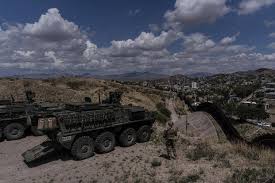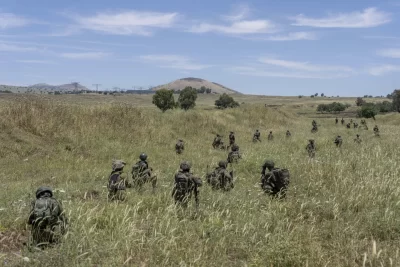
NOGALES, Ariz. — Inside an armored vehicle, an Army scout uses a joystick to direct a long-range optical scope toward a man perched atop the U.S.-Mexico border wall cutting across the hills of this Arizona frontier community.
The man lowers himself toward U.S. soil between coils of concertina wire. Shouts ring out, an alert is sounded and a U.S. Border Patrol SUV races toward the wall — warning enough to send the man scrambling back over it, disappearing into Mexico.
The sighting Tuesday was one of only two for the Army infantry unit patrolling this sector of the southern border, where an emergency declaration by President Donald Trump has thrust the military into a central role in deterring migrant crossings between U.S. ports of entry.
“Deterrence is actually boring,” said 24-year-old Army Sgt. Ana Harker-Molina, voicing the tedium felt by some soldiers over the sporadic sightings during two days in which The Associated Press embedded with the military on the border.
Still, she said she takes pride in the work, knowing that troops discourage crossings by their mere presence.
“Just if we’re sitting here watching the border, it’s helping our country,” said Harker-Molina, an immigrant herself who came from Panama at age 12 and became a U.S. citizen two years ago while serving in the Army.
U.S. troop deployments at the border have tripled to 7,600 and include every branch of the military — even as the number of attempted illegal crossings plummet and Trump has authorized funding for an additional 3,000 Border Patrol agents, offering $10,000 signing and retention bonuses.
The military mission is guided from a new command center at a remote Army intelligence training base alongside southern Arizona’s Huachuca Mountains. There, a community hall has been transformed into a bustling war room of battalion commanders and staff with digital maps pinpointing military camps and movements along the nearly 2,000-mile border. Until now border enforcement had been the domain of civilian law enforcement, with the military only intermittently stepping in.
But since April, large swaths of border have been designated militarized zones, empowering U.S. troops to apprehend immigrants and others accused of trespassing on Army, Air Force or Navy bases, and authorizing additional criminal charges that can mean prison time.
The two-star general leading the mission says troops are being untethered from maintenance and warehouse tasks to work closely with U.S. Border Patrol agents in high-traffic areas for illegal crossings — and to deploy rapidly to remote, unguarded terrain.
“We don’t have a (labor) union, there’s no limit on how many hours we can work in a day, how many shifts we can man,” said Army Maj. Gen. Scott Naumann.
“I can put soldiers out whenever we need to in order to get after the problem and we can put them out for days at a time, we can fly people into incredibly remote areas now that we see the cartels shifting” course.
Patrols aimed at stopping ‘got-aways’
At Nogales, Army scouts patrolled the border in full battle gear — helmet, M4 service rifle, bullet-resistant vest — with the right to use deadly force if attacked under standing military rules integrated into the border mission. Underfoot, smugglers for decades routinely attempted to tunnel into stormwater drains to ferry contraband into the U.S.
Naumann’s command post oversees an armada of 117 armored Stryker vehicles, more than 35 helicopters and a half-dozen long-distance drones that can survey the border day and night with sensors to pinpoint people wandering the desert. Marine Corps engineers are adding concertina wire to slow crossings, as the Trump administration reboots border wall construction.




